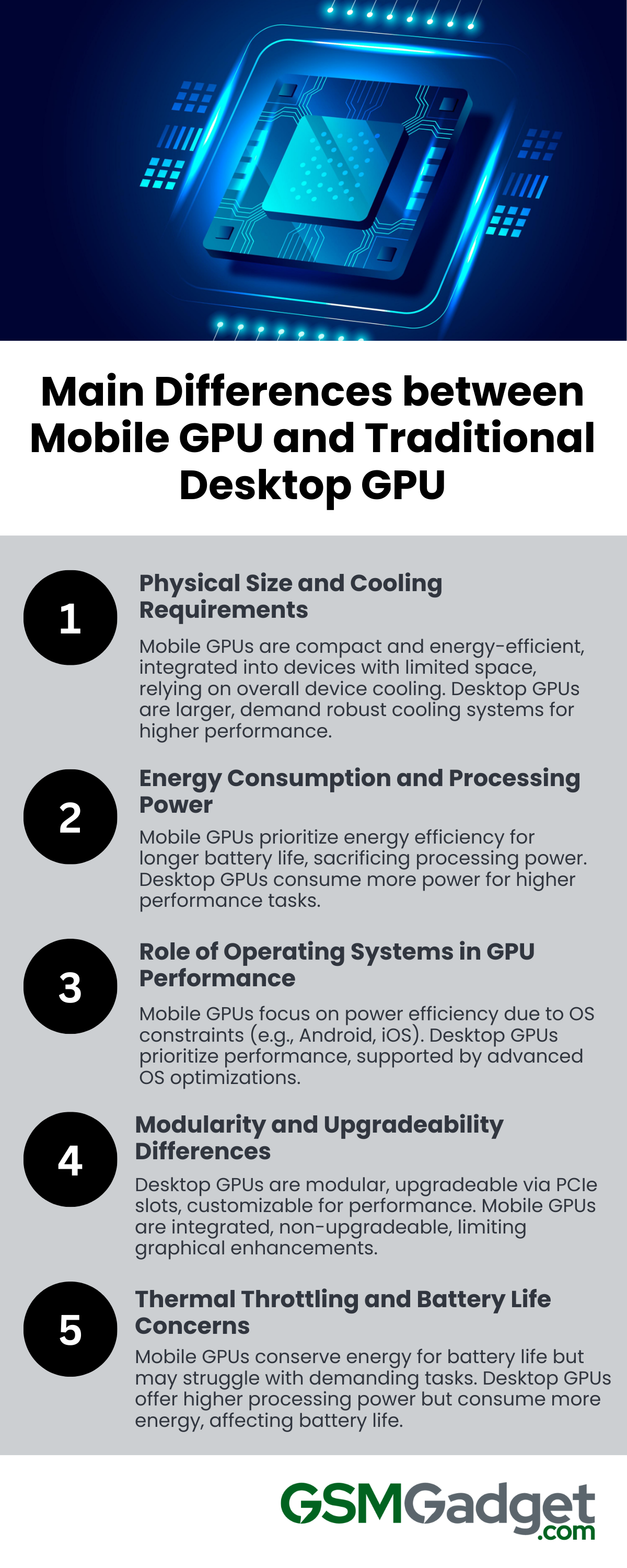Mobile and traditional desktop GPUs are optimized for their specific environments. Mobile GPUs are designed for energy efficiency and space conservation in portable devices such as smartphones and tablets. They are integrated into system-on-a-chip (SoC) configurations, operate at lower processing power, and utilize techniques like depth wise separable convolution to enhance tasks like object detection. Power gating is also utilized to effectively manage power consumption.
On the other hand, desktop GPUs are standalone units with dedicated cooling systems, designed for higher performance and handling complex tasks like gaming and 3D rendering. They have more memory, wider memory buses, and faster memory types like GDDR6X, allowing them to handle larger datasets and deliver higher frame rates. While mobile GPUs are limited by power draw and potential thermal throttling in laptops, desktop GPUs can maintain higher performance levels due to their robust cooling solutions and dedicated power supplies.
Despite these differences, both types of GPUs strive to deliver optimal graphics performance within the constraints of their respective devices.
Major differences are:

1. Physical Size and Cooling Requirements
Mobile GPUs are designed with compactness and energy efficiency in mind to meet the space and power limitations of portable devices such as laptops, smartphones, and tablets. They are typically smaller and integrated into the device’s main processor as a system-on-chip (SoC). Mobile GPUs have less demanding cooling requirements, which helps extend battery life and manage heat efficiently in a confined space.
On the other hand, desktop GPUs are larger standalone cards that fit into desktop computer cases with fewer size restrictions. They offer higher performance and power consumption, resulting in increased heat output that requires robust cooling solutions such as larger heatsinks, fans, or liquid cooling systems to maintain optimal temperatures and performance. While desktop GPUs often require dedicated cooling systems, mobile GPUs rely on the overall cooling solution of the device.
2. Energy Consumption and processing power
Mobile GPUs are designed with a focus on energy efficiency to meet the power restrictions of battery-powered devices such as smartphones and tablets. They typically consume only a small amount of power, prioritizing reduced energy usage to prolong battery life and enable passive cooling. However, this design approach often results in lower processing capabilities, causing mobile GPUs to struggle with demanding graphics tasks.
On the flip side, desktop GPUs are optimized for higher processing power to handle intensive applications like gaming, video editing, and 3D rendering. They operate with fewer limitations on energy usage, consuming significantly more power, sometimes reaching hundreds of watts, and requiring more advanced cooling solutions. This makes desktop GPUs less suitable for situations where conserving battery life is crucial.
3. The role of operating systems in GPU performance
Mobile and traditional desktop GPUs are tailored to meet the distinct demands of their operating systems, influencing their design and performance. Mobile GPUs, integrated within a System on a Chip (SoC) for devices like smartphones and tablets, prioritize power efficiency and thermal management due to space constraints and the need for prolonged battery life. This results in fewer processing cores and lower clock speeds. Operating systems like Android and iOS support these goals with optimizations for multitasking and power conservation.
On the contrary, desktop GPUs are engineered for higher performance, with more cores, higher clock speeds, and greater memory bandwidth to manage demanding tasks such as gaming and 3D rendering. Desktop operating systems, including Windows, macOS, and Linux, offer advanced driver support and optimizations to leverage the full capabilities of these GPUs. The performance disparity between mobile and desktop GPUs is further exacerbated by the different approaches to hardware rasterization, memory architecture, and display resolutions. Additionally, mobile GPUs are not fully utilized for deep learning inference, partly due to the inefficient distribution of compute workload. Understanding these differences is essential for optimizing GPU performance to suit the specific needs of mobile versus desktop computing environments.
4. Modularity and Upgradeability Differences
Desktop GPUs are modular, allowing for easy upgrades or replacements via standardized expansion slots like PCIe, which caters to users seeking to enhance performance or adopt new technologies. They also offer customization options for cooling and power delivery, providing flexibility to meet the demands of graphically intensive applications.
In contrast, mobile GPUs are typically integrated into the device’s motherboard or system-on-a-chip (SoC), rendering them non-upgradeable and inseparable from the system. This integration, while optimizing for space and power efficiency in portable devices, limits the ability to improve graphical capabilities without purchasing a new device. Additionally, mobile GPUs may not support general-purpose APIs such as OpenCL, which restricts their programmability compared to their desktop counterparts. As a result, while desktop GPUs afford users the ability to keep pace with technological advancements, mobile GPUs offer a fixed level of performance at the time of purchase.
5. Thermal Throttling and Battery Life Concerns
Mobile GPUs are designed with a focus on energy efficiency to meet the power constraints of battery-powered devices such as smartphones and tablets. They typically consume minimal power to prioritize reduced energy usage, extending battery life and enabling passive cooling. However, this design approach often results in lower processing capabilities, causing mobile GPUs to struggle with demanding graphics tasks.
On the other side, desktop GPUs are optimized for higher processing power to handle intensive applications such as gaming, video editing, and 3D rendering. They operate with fewer restrictions on energy consumption, consuming significantly more power, sometimes reaching hundreds of watts, and requiring more advanced cooling solutions. This makes desktop GPUs less suitable for situations where preserving battery life is crucial.
